Capstone Project's Impact on Inclusive Education: Literature Review
VerifiedAdded on 2019/10/30
|9
|1992
|372
Report
AI Summary
This literature review examines the impact of capstone projects on inclusive education, focusing on the experiences of students with special needs. It explores key aspects such as the implementation of inclusive education, special needs behavior in general classrooms, the role of peer interaction, and the academic performance of students in these settings. The review highlights both the benefits and challenges associated with inclusive education, including the potential for bullying and the need for effective classroom management. Several studies are discussed, providing insights into the attitudes of teachers, the importance of social interaction, and the effectiveness of different intervention methods. The review identifies gaps in the current literature, particularly in addressing issues like bullying, and concludes by emphasizing the importance of inclusive education with appropriate structures to maximize positive outcomes for all students.
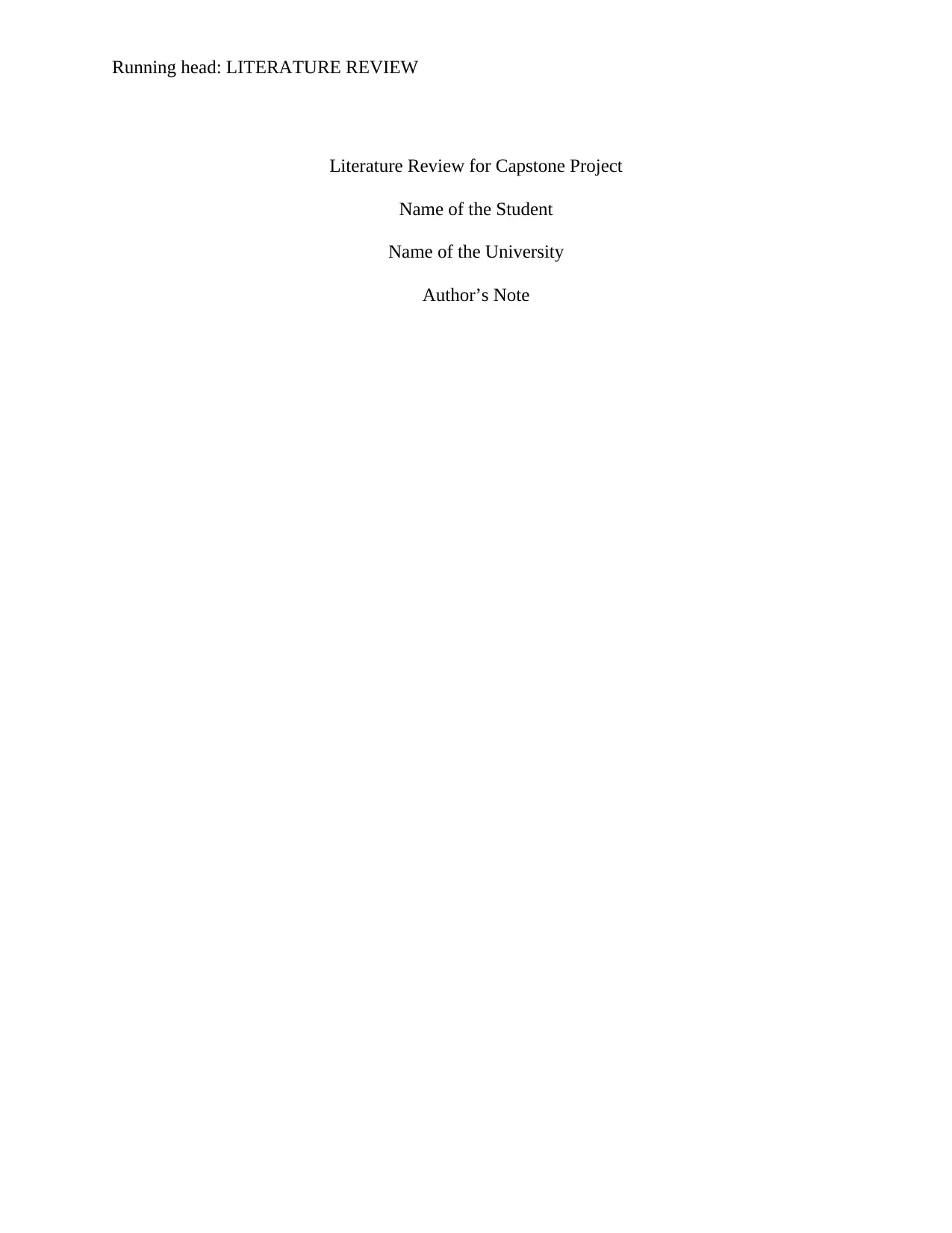
Running head: LITERATURE REVIEW
Literature Review for Capstone Project
Name of the Student
Name of the University
Author’s Note
Literature Review for Capstone Project
Name of the Student
Name of the University
Author’s Note
Paraphrase This Document
Need a fresh take? Get an instant paraphrase of this document with our AI Paraphraser
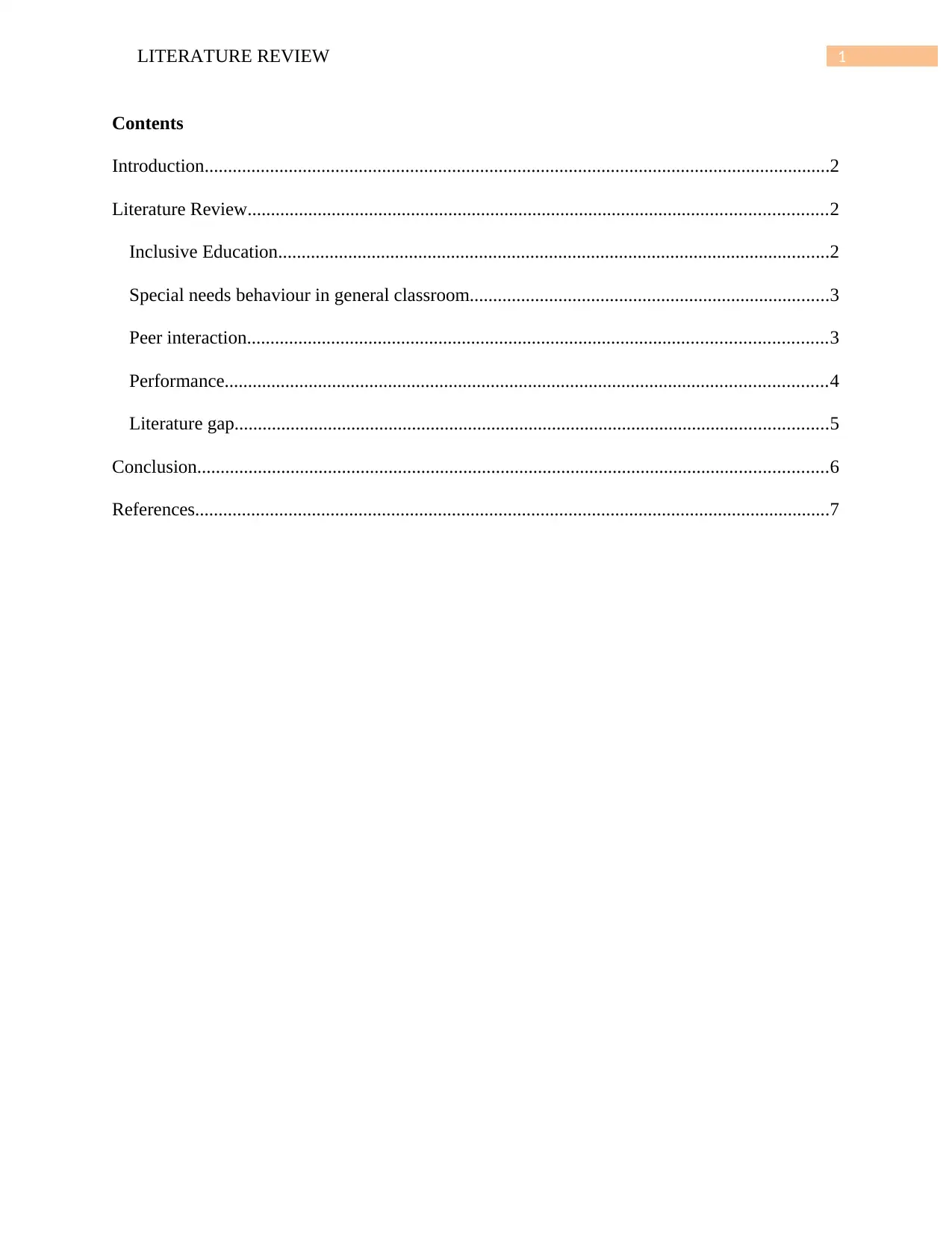
1LITERATURE REVIEW
Contents
Introduction......................................................................................................................................2
Literature Review............................................................................................................................2
Inclusive Education......................................................................................................................2
Special needs behaviour in general classroom.............................................................................3
Peer interaction............................................................................................................................3
Performance.................................................................................................................................4
Literature gap...............................................................................................................................5
Conclusion.......................................................................................................................................6
References........................................................................................................................................7
Contents
Introduction......................................................................................................................................2
Literature Review............................................................................................................................2
Inclusive Education......................................................................................................................2
Special needs behaviour in general classroom.............................................................................3
Peer interaction............................................................................................................................3
Performance.................................................................................................................................4
Literature gap...............................................................................................................................5
Conclusion.......................................................................................................................................6
References........................................................................................................................................7
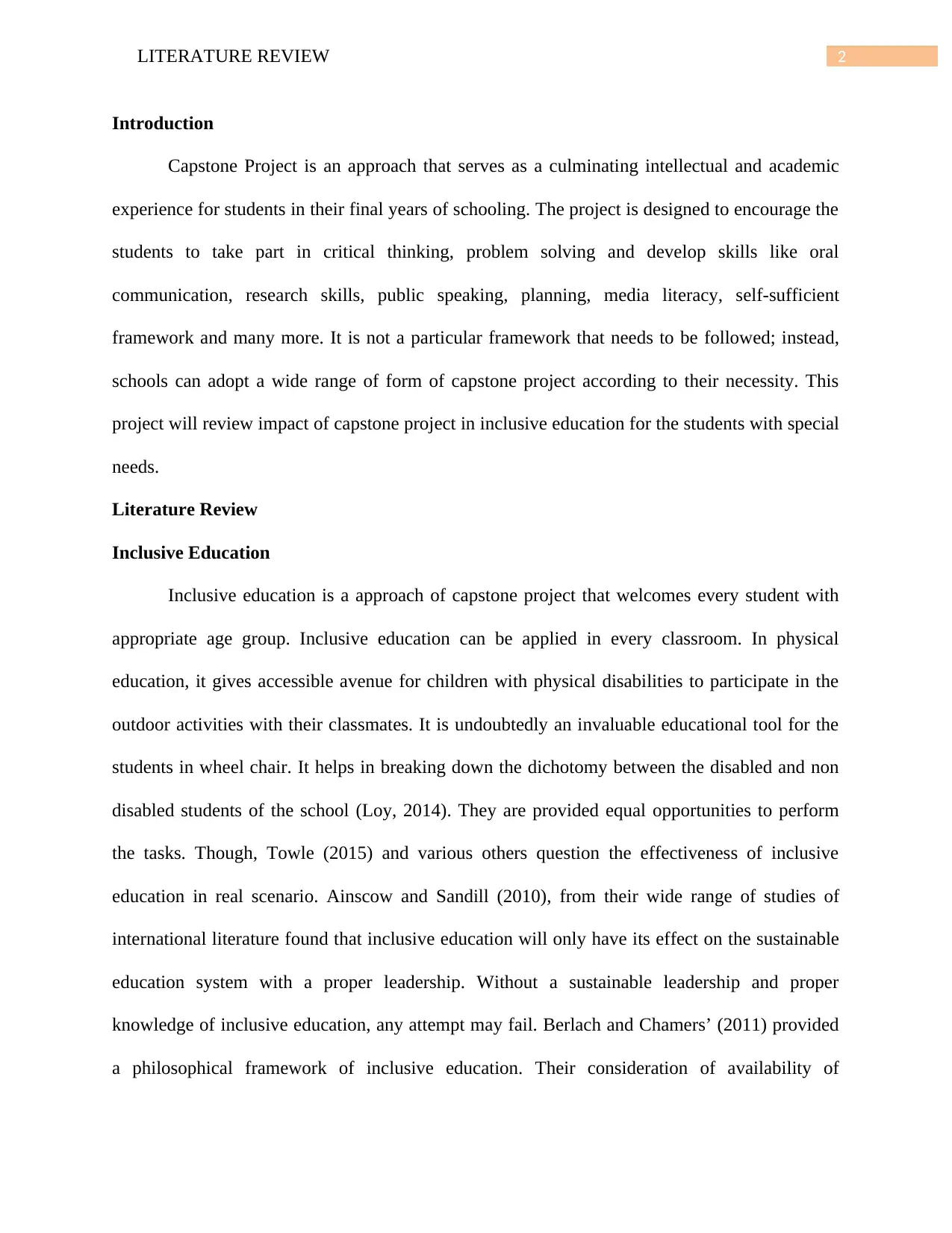
2LITERATURE REVIEW
Introduction
Capstone Project is an approach that serves as a culminating intellectual and academic
experience for students in their final years of schooling. The project is designed to encourage the
students to take part in critical thinking, problem solving and develop skills like oral
communication, research skills, public speaking, planning, media literacy, self-sufficient
framework and many more. It is not a particular framework that needs to be followed; instead,
schools can adopt a wide range of form of capstone project according to their necessity. This
project will review impact of capstone project in inclusive education for the students with special
needs.
Literature Review
Inclusive Education
Inclusive education is a approach of capstone project that welcomes every student with
appropriate age group. Inclusive education can be applied in every classroom. In physical
education, it gives accessible avenue for children with physical disabilities to participate in the
outdoor activities with their classmates. It is undoubtedly an invaluable educational tool for the
students in wheel chair. It helps in breaking down the dichotomy between the disabled and non
disabled students of the school (Loy, 2014). They are provided equal opportunities to perform
the tasks. Though, Towle (2015) and various others question the effectiveness of inclusive
education in real scenario. Ainscow and Sandill (2010), from their wide range of studies of
international literature found that inclusive education will only have its effect on the sustainable
education system with a proper leadership. Without a sustainable leadership and proper
knowledge of inclusive education, any attempt may fail. Berlach and Chamers’ (2011) provided
a philosophical framework of inclusive education. Their consideration of availability of
Introduction
Capstone Project is an approach that serves as a culminating intellectual and academic
experience for students in their final years of schooling. The project is designed to encourage the
students to take part in critical thinking, problem solving and develop skills like oral
communication, research skills, public speaking, planning, media literacy, self-sufficient
framework and many more. It is not a particular framework that needs to be followed; instead,
schools can adopt a wide range of form of capstone project according to their necessity. This
project will review impact of capstone project in inclusive education for the students with special
needs.
Literature Review
Inclusive Education
Inclusive education is a approach of capstone project that welcomes every student with
appropriate age group. Inclusive education can be applied in every classroom. In physical
education, it gives accessible avenue for children with physical disabilities to participate in the
outdoor activities with their classmates. It is undoubtedly an invaluable educational tool for the
students in wheel chair. It helps in breaking down the dichotomy between the disabled and non
disabled students of the school (Loy, 2014). They are provided equal opportunities to perform
the tasks. Though, Towle (2015) and various others question the effectiveness of inclusive
education in real scenario. Ainscow and Sandill (2010), from their wide range of studies of
international literature found that inclusive education will only have its effect on the sustainable
education system with a proper leadership. Without a sustainable leadership and proper
knowledge of inclusive education, any attempt may fail. Berlach and Chamers’ (2011) provided
a philosophical framework of inclusive education. Their consideration of availability of
⊘ This is a preview!⊘
Do you want full access?
Subscribe today to unlock all pages.

Trusted by 1+ million students worldwide
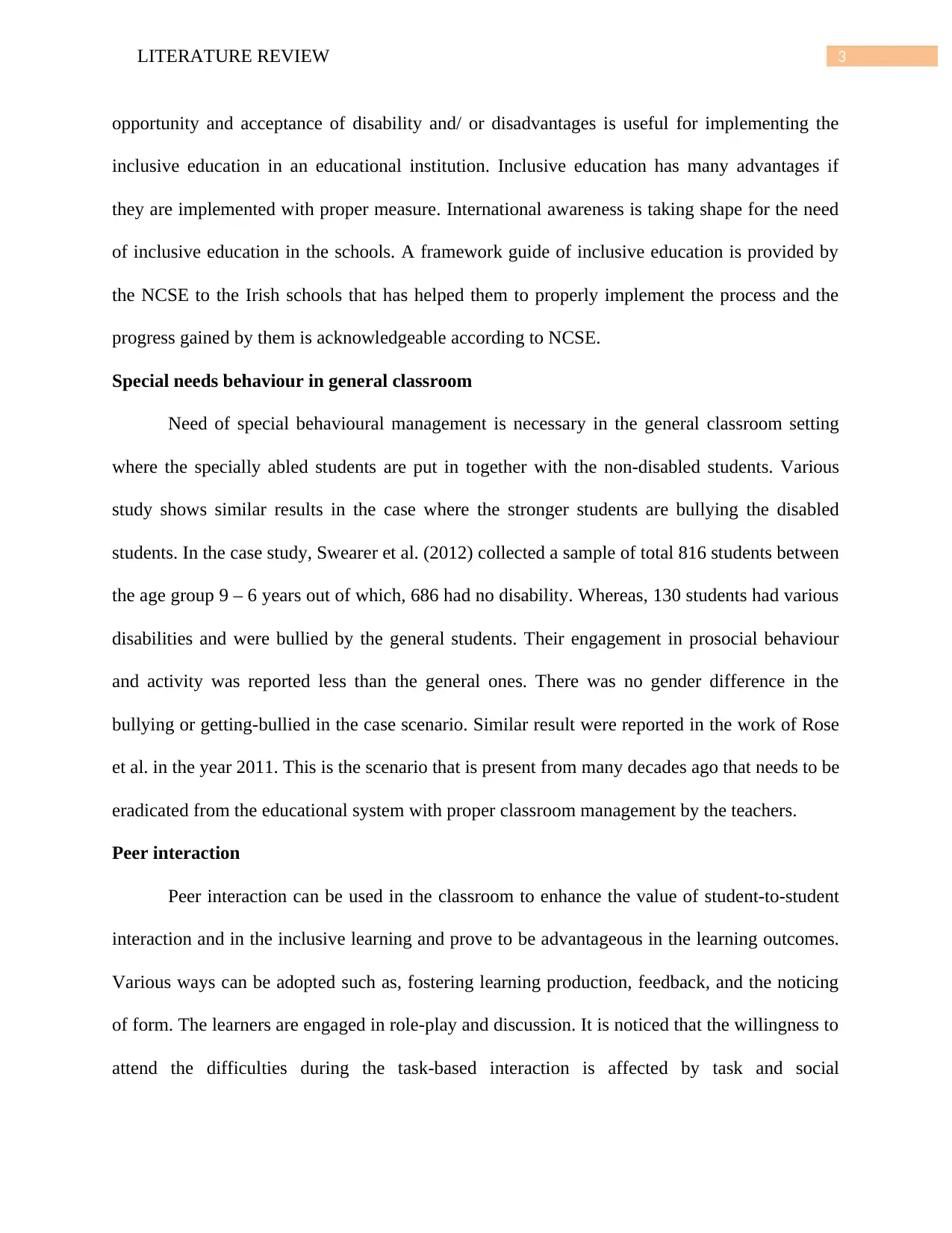
3LITERATURE REVIEW
opportunity and acceptance of disability and/ or disadvantages is useful for implementing the
inclusive education in an educational institution. Inclusive education has many advantages if
they are implemented with proper measure. International awareness is taking shape for the need
of inclusive education in the schools. A framework guide of inclusive education is provided by
the NCSE to the Irish schools that has helped them to properly implement the process and the
progress gained by them is acknowledgeable according to NCSE.
Special needs behaviour in general classroom
Need of special behavioural management is necessary in the general classroom setting
where the specially abled students are put in together with the non-disabled students. Various
study shows similar results in the case where the stronger students are bullying the disabled
students. In the case study, Swearer et al. (2012) collected a sample of total 816 students between
the age group 9 – 6 years out of which, 686 had no disability. Whereas, 130 students had various
disabilities and were bullied by the general students. Their engagement in prosocial behaviour
and activity was reported less than the general ones. There was no gender difference in the
bullying or getting-bullied in the case scenario. Similar result were reported in the work of Rose
et al. in the year 2011. This is the scenario that is present from many decades ago that needs to be
eradicated from the educational system with proper classroom management by the teachers.
Peer interaction
Peer interaction can be used in the classroom to enhance the value of student-to-student
interaction and in the inclusive learning and prove to be advantageous in the learning outcomes.
Various ways can be adopted such as, fostering learning production, feedback, and the noticing
of form. The learners are engaged in role-play and discussion. It is noticed that the willingness to
attend the difficulties during the task-based interaction is affected by task and social
opportunity and acceptance of disability and/ or disadvantages is useful for implementing the
inclusive education in an educational institution. Inclusive education has many advantages if
they are implemented with proper measure. International awareness is taking shape for the need
of inclusive education in the schools. A framework guide of inclusive education is provided by
the NCSE to the Irish schools that has helped them to properly implement the process and the
progress gained by them is acknowledgeable according to NCSE.
Special needs behaviour in general classroom
Need of special behavioural management is necessary in the general classroom setting
where the specially abled students are put in together with the non-disabled students. Various
study shows similar results in the case where the stronger students are bullying the disabled
students. In the case study, Swearer et al. (2012) collected a sample of total 816 students between
the age group 9 – 6 years out of which, 686 had no disability. Whereas, 130 students had various
disabilities and were bullied by the general students. Their engagement in prosocial behaviour
and activity was reported less than the general ones. There was no gender difference in the
bullying or getting-bullied in the case scenario. Similar result were reported in the work of Rose
et al. in the year 2011. This is the scenario that is present from many decades ago that needs to be
eradicated from the educational system with proper classroom management by the teachers.
Peer interaction
Peer interaction can be used in the classroom to enhance the value of student-to-student
interaction and in the inclusive learning and prove to be advantageous in the learning outcomes.
Various ways can be adopted such as, fostering learning production, feedback, and the noticing
of form. The learners are engaged in role-play and discussion. It is noticed that the willingness to
attend the difficulties during the task-based interaction is affected by task and social
Paraphrase This Document
Need a fresh take? Get an instant paraphrase of this document with our AI Paraphraser
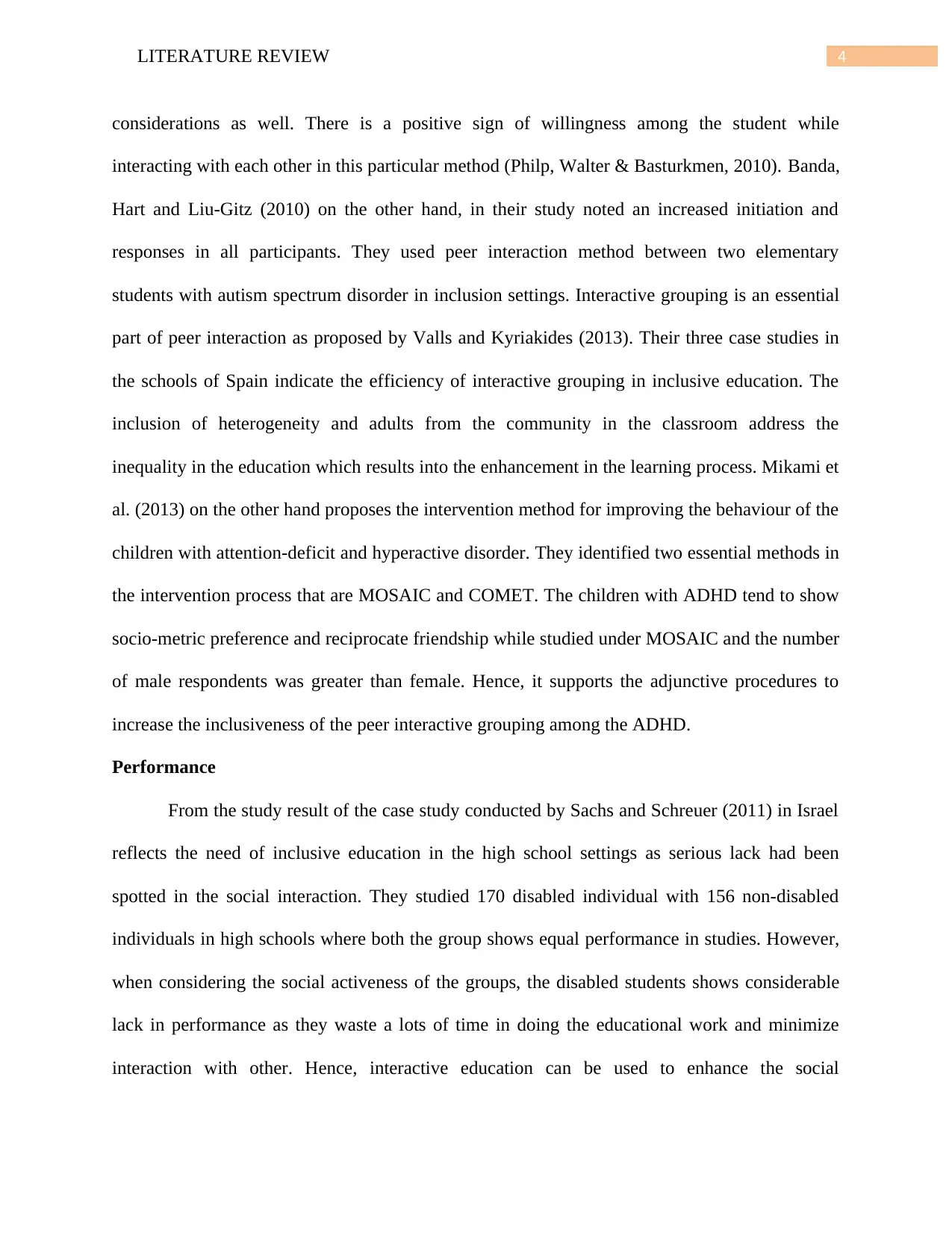
4LITERATURE REVIEW
considerations as well. There is a positive sign of willingness among the student while
interacting with each other in this particular method (Philp, Walter & Basturkmen, 2010). Banda,
Hart and Liu-Gitz (2010) on the other hand, in their study noted an increased initiation and
responses in all participants. They used peer interaction method between two elementary
students with autism spectrum disorder in inclusion settings. Interactive grouping is an essential
part of peer interaction as proposed by Valls and Kyriakides (2013). Their three case studies in
the schools of Spain indicate the efficiency of interactive grouping in inclusive education. The
inclusion of heterogeneity and adults from the community in the classroom address the
inequality in the education which results into the enhancement in the learning process. Mikami et
al. (2013) on the other hand proposes the intervention method for improving the behaviour of the
children with attention-deficit and hyperactive disorder. They identified two essential methods in
the intervention process that are MOSAIC and COMET. The children with ADHD tend to show
socio-metric preference and reciprocate friendship while studied under MOSAIC and the number
of male respondents was greater than female. Hence, it supports the adjunctive procedures to
increase the inclusiveness of the peer interactive grouping among the ADHD.
Performance
From the study result of the case study conducted by Sachs and Schreuer (2011) in Israel
reflects the need of inclusive education in the high school settings as serious lack had been
spotted in the social interaction. They studied 170 disabled individual with 156 non-disabled
individuals in high schools where both the group shows equal performance in studies. However,
when considering the social activeness of the groups, the disabled students shows considerable
lack in performance as they waste a lots of time in doing the educational work and minimize
interaction with other. Hence, interactive education can be used to enhance the social
considerations as well. There is a positive sign of willingness among the student while
interacting with each other in this particular method (Philp, Walter & Basturkmen, 2010). Banda,
Hart and Liu-Gitz (2010) on the other hand, in their study noted an increased initiation and
responses in all participants. They used peer interaction method between two elementary
students with autism spectrum disorder in inclusion settings. Interactive grouping is an essential
part of peer interaction as proposed by Valls and Kyriakides (2013). Their three case studies in
the schools of Spain indicate the efficiency of interactive grouping in inclusive education. The
inclusion of heterogeneity and adults from the community in the classroom address the
inequality in the education which results into the enhancement in the learning process. Mikami et
al. (2013) on the other hand proposes the intervention method for improving the behaviour of the
children with attention-deficit and hyperactive disorder. They identified two essential methods in
the intervention process that are MOSAIC and COMET. The children with ADHD tend to show
socio-metric preference and reciprocate friendship while studied under MOSAIC and the number
of male respondents was greater than female. Hence, it supports the adjunctive procedures to
increase the inclusiveness of the peer interactive grouping among the ADHD.
Performance
From the study result of the case study conducted by Sachs and Schreuer (2011) in Israel
reflects the need of inclusive education in the high school settings as serious lack had been
spotted in the social interaction. They studied 170 disabled individual with 156 non-disabled
individuals in high schools where both the group shows equal performance in studies. However,
when considering the social activeness of the groups, the disabled students shows considerable
lack in performance as they waste a lots of time in doing the educational work and minimize
interaction with other. Hence, interactive education can be used to enhance the social
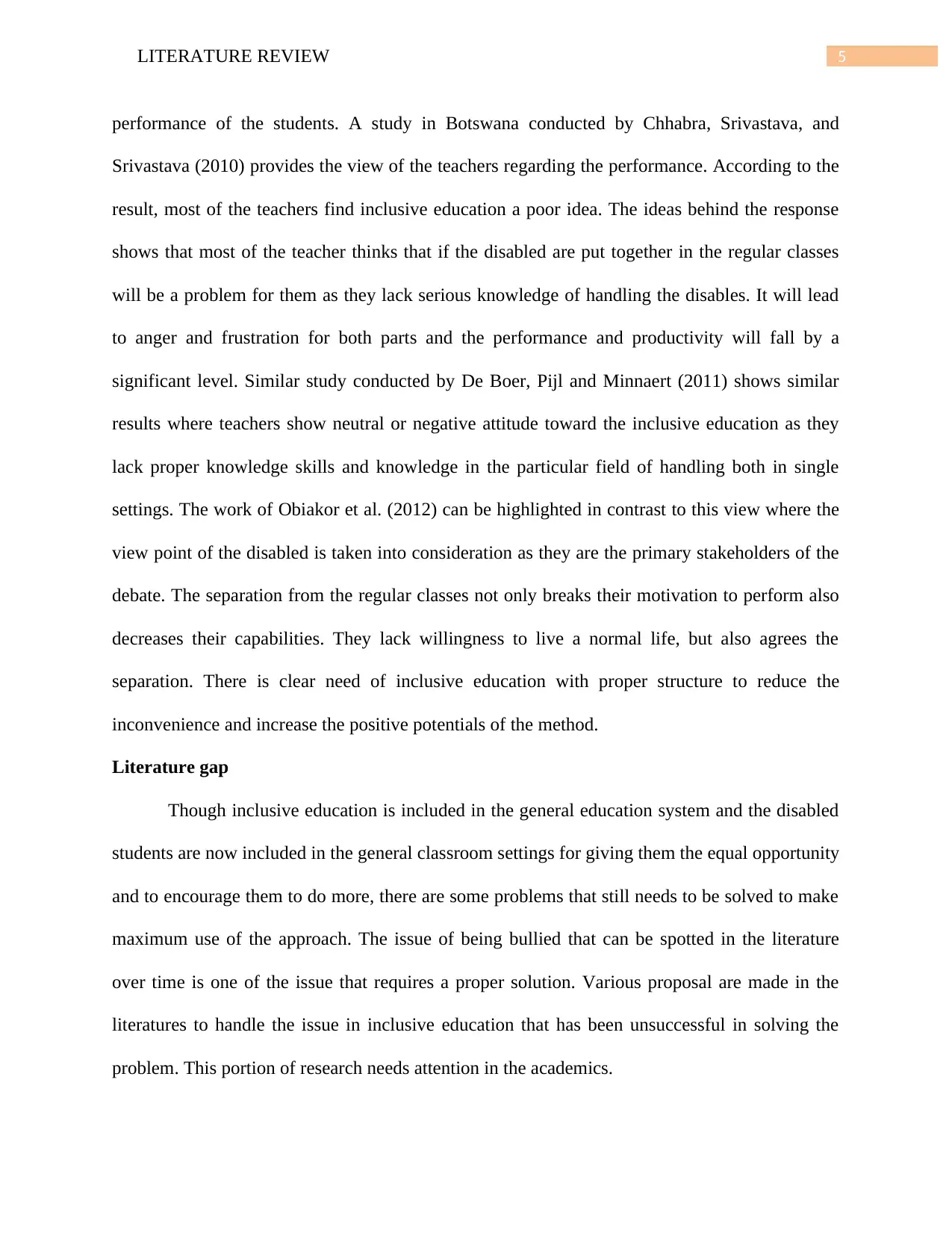
5LITERATURE REVIEW
performance of the students. A study in Botswana conducted by Chhabra, Srivastava, and
Srivastava (2010) provides the view of the teachers regarding the performance. According to the
result, most of the teachers find inclusive education a poor idea. The ideas behind the response
shows that most of the teacher thinks that if the disabled are put together in the regular classes
will be a problem for them as they lack serious knowledge of handling the disables. It will lead
to anger and frustration for both parts and the performance and productivity will fall by a
significant level. Similar study conducted by De Boer, Pijl and Minnaert (2011) shows similar
results where teachers show neutral or negative attitude toward the inclusive education as they
lack proper knowledge skills and knowledge in the particular field of handling both in single
settings. The work of Obiakor et al. (2012) can be highlighted in contrast to this view where the
view point of the disabled is taken into consideration as they are the primary stakeholders of the
debate. The separation from the regular classes not only breaks their motivation to perform also
decreases their capabilities. They lack willingness to live a normal life, but also agrees the
separation. There is clear need of inclusive education with proper structure to reduce the
inconvenience and increase the positive potentials of the method.
Literature gap
Though inclusive education is included in the general education system and the disabled
students are now included in the general classroom settings for giving them the equal opportunity
and to encourage them to do more, there are some problems that still needs to be solved to make
maximum use of the approach. The issue of being bullied that can be spotted in the literature
over time is one of the issue that requires a proper solution. Various proposal are made in the
literatures to handle the issue in inclusive education that has been unsuccessful in solving the
problem. This portion of research needs attention in the academics.
performance of the students. A study in Botswana conducted by Chhabra, Srivastava, and
Srivastava (2010) provides the view of the teachers regarding the performance. According to the
result, most of the teachers find inclusive education a poor idea. The ideas behind the response
shows that most of the teacher thinks that if the disabled are put together in the regular classes
will be a problem for them as they lack serious knowledge of handling the disables. It will lead
to anger and frustration for both parts and the performance and productivity will fall by a
significant level. Similar study conducted by De Boer, Pijl and Minnaert (2011) shows similar
results where teachers show neutral or negative attitude toward the inclusive education as they
lack proper knowledge skills and knowledge in the particular field of handling both in single
settings. The work of Obiakor et al. (2012) can be highlighted in contrast to this view where the
view point of the disabled is taken into consideration as they are the primary stakeholders of the
debate. The separation from the regular classes not only breaks their motivation to perform also
decreases their capabilities. They lack willingness to live a normal life, but also agrees the
separation. There is clear need of inclusive education with proper structure to reduce the
inconvenience and increase the positive potentials of the method.
Literature gap
Though inclusive education is included in the general education system and the disabled
students are now included in the general classroom settings for giving them the equal opportunity
and to encourage them to do more, there are some problems that still needs to be solved to make
maximum use of the approach. The issue of being bullied that can be spotted in the literature
over time is one of the issue that requires a proper solution. Various proposal are made in the
literatures to handle the issue in inclusive education that has been unsuccessful in solving the
problem. This portion of research needs attention in the academics.
⊘ This is a preview!⊘
Do you want full access?
Subscribe today to unlock all pages.

Trusted by 1+ million students worldwide
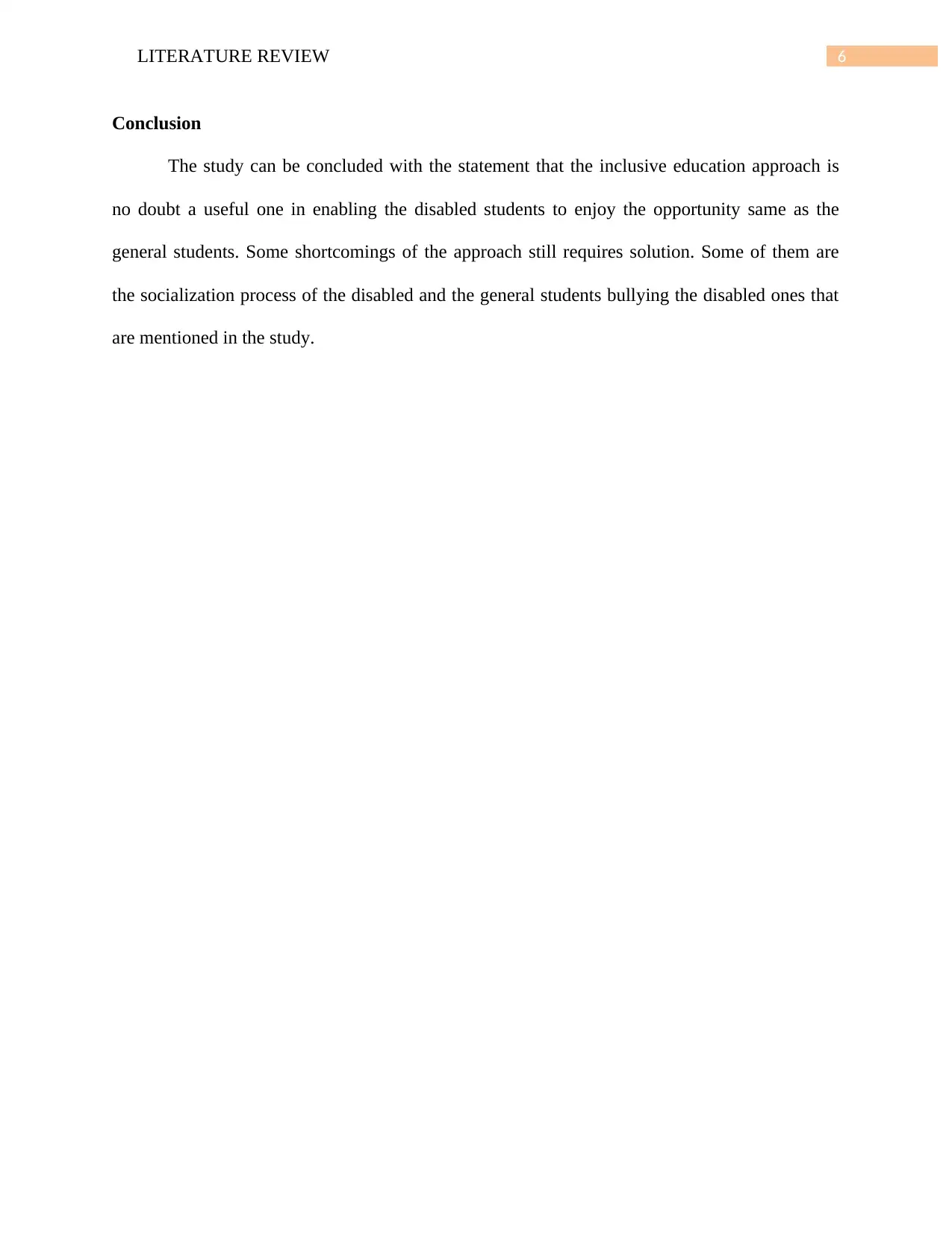
6LITERATURE REVIEW
Conclusion
The study can be concluded with the statement that the inclusive education approach is
no doubt a useful one in enabling the disabled students to enjoy the opportunity same as the
general students. Some shortcomings of the approach still requires solution. Some of them are
the socialization process of the disabled and the general students bullying the disabled ones that
are mentioned in the study.
Conclusion
The study can be concluded with the statement that the inclusive education approach is
no doubt a useful one in enabling the disabled students to enjoy the opportunity same as the
general students. Some shortcomings of the approach still requires solution. Some of them are
the socialization process of the disabled and the general students bullying the disabled ones that
are mentioned in the study.
Paraphrase This Document
Need a fresh take? Get an instant paraphrase of this document with our AI Paraphraser
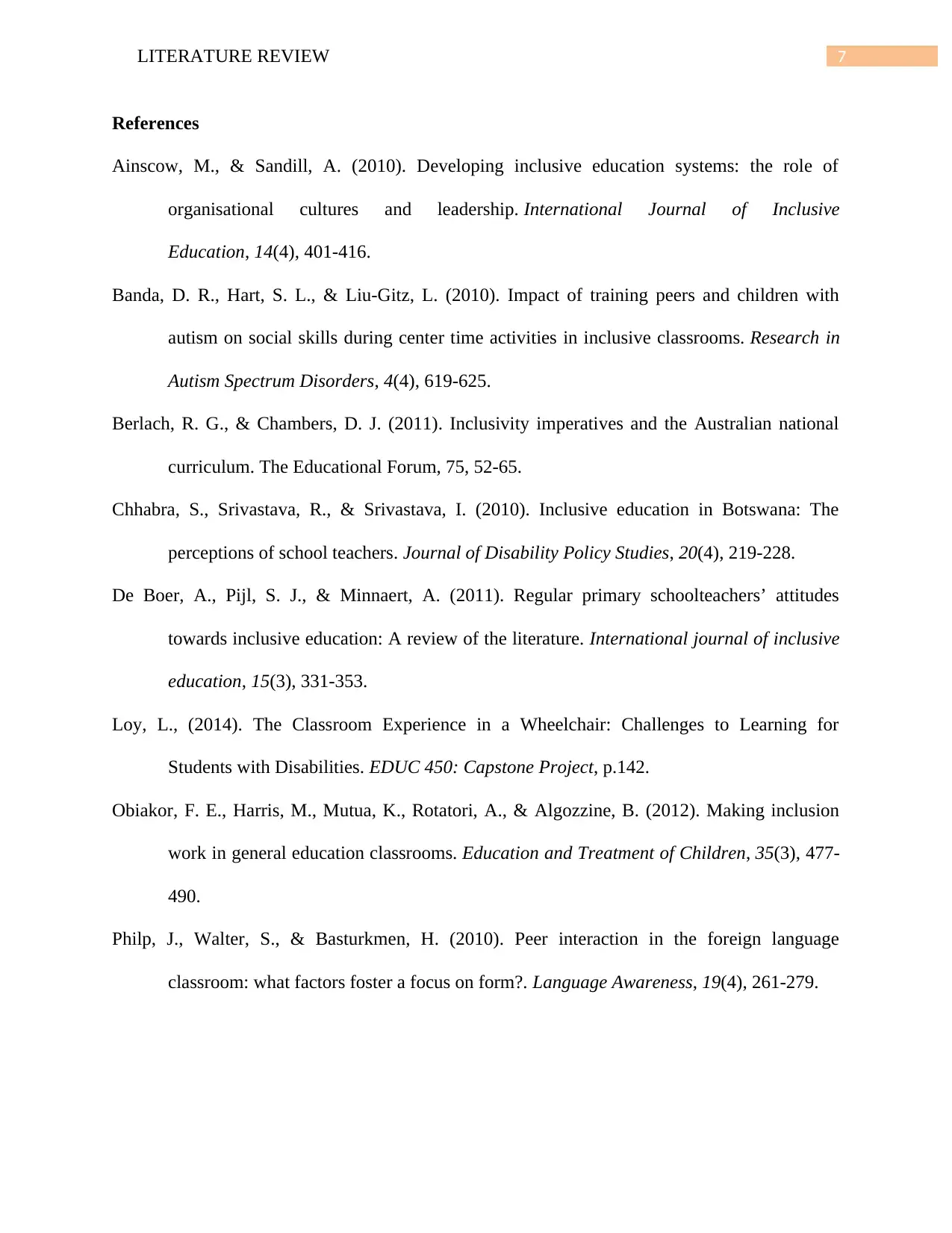
7LITERATURE REVIEW
References
Ainscow, M., & Sandill, A. (2010). Developing inclusive education systems: the role of
organisational cultures and leadership. International Journal of Inclusive
Education, 14(4), 401-416.
Banda, D. R., Hart, S. L., & Liu-Gitz, L. (2010). Impact of training peers and children with
autism on social skills during center time activities in inclusive classrooms. Research in
Autism Spectrum Disorders, 4(4), 619-625.
Berlach, R. G., & Chambers, D. J. (2011). Inclusivity imperatives and the Australian national
curriculum. The Educational Forum, 75, 52-65.
Chhabra, S., Srivastava, R., & Srivastava, I. (2010). Inclusive education in Botswana: The
perceptions of school teachers. Journal of Disability Policy Studies, 20(4), 219-228.
De Boer, A., Pijl, S. J., & Minnaert, A. (2011). Regular primary schoolteachers’ attitudes
towards inclusive education: A review of the literature. International journal of inclusive
education, 15(3), 331-353.
Loy, L., (2014). The Classroom Experience in a Wheelchair: Challenges to Learning for
Students with Disabilities. EDUC 450: Capstone Project, p.142.
Obiakor, F. E., Harris, M., Mutua, K., Rotatori, A., & Algozzine, B. (2012). Making inclusion
work in general education classrooms. Education and Treatment of Children, 35(3), 477-
490.
Philp, J., Walter, S., & Basturkmen, H. (2010). Peer interaction in the foreign language
classroom: what factors foster a focus on form?. Language Awareness, 19(4), 261-279.
References
Ainscow, M., & Sandill, A. (2010). Developing inclusive education systems: the role of
organisational cultures and leadership. International Journal of Inclusive
Education, 14(4), 401-416.
Banda, D. R., Hart, S. L., & Liu-Gitz, L. (2010). Impact of training peers and children with
autism on social skills during center time activities in inclusive classrooms. Research in
Autism Spectrum Disorders, 4(4), 619-625.
Berlach, R. G., & Chambers, D. J. (2011). Inclusivity imperatives and the Australian national
curriculum. The Educational Forum, 75, 52-65.
Chhabra, S., Srivastava, R., & Srivastava, I. (2010). Inclusive education in Botswana: The
perceptions of school teachers. Journal of Disability Policy Studies, 20(4), 219-228.
De Boer, A., Pijl, S. J., & Minnaert, A. (2011). Regular primary schoolteachers’ attitudes
towards inclusive education: A review of the literature. International journal of inclusive
education, 15(3), 331-353.
Loy, L., (2014). The Classroom Experience in a Wheelchair: Challenges to Learning for
Students with Disabilities. EDUC 450: Capstone Project, p.142.
Obiakor, F. E., Harris, M., Mutua, K., Rotatori, A., & Algozzine, B. (2012). Making inclusion
work in general education classrooms. Education and Treatment of Children, 35(3), 477-
490.
Philp, J., Walter, S., & Basturkmen, H. (2010). Peer interaction in the foreign language
classroom: what factors foster a focus on form?. Language Awareness, 19(4), 261-279.
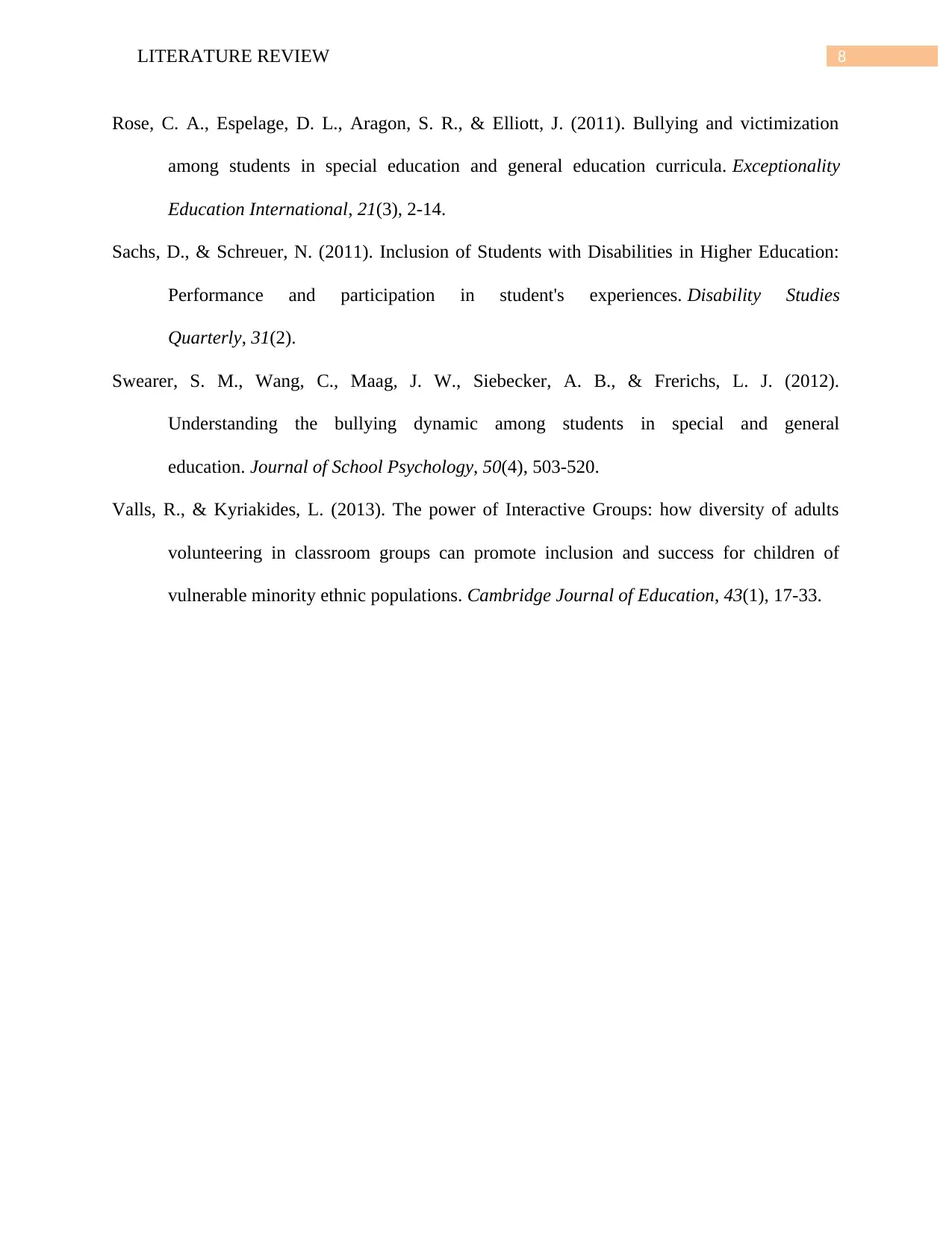
8LITERATURE REVIEW
Rose, C. A., Espelage, D. L., Aragon, S. R., & Elliott, J. (2011). Bullying and victimization
among students in special education and general education curricula. Exceptionality
Education International, 21(3), 2-14.
Sachs, D., & Schreuer, N. (2011). Inclusion of Students with Disabilities in Higher Education:
Performance and participation in student's experiences. Disability Studies
Quarterly, 31(2).
Swearer, S. M., Wang, C., Maag, J. W., Siebecker, A. B., & Frerichs, L. J. (2012).
Understanding the bullying dynamic among students in special and general
education. Journal of School Psychology, 50(4), 503-520.
Valls, R., & Kyriakides, L. (2013). The power of Interactive Groups: how diversity of adults
volunteering in classroom groups can promote inclusion and success for children of
vulnerable minority ethnic populations. Cambridge Journal of Education, 43(1), 17-33.
Rose, C. A., Espelage, D. L., Aragon, S. R., & Elliott, J. (2011). Bullying and victimization
among students in special education and general education curricula. Exceptionality
Education International, 21(3), 2-14.
Sachs, D., & Schreuer, N. (2011). Inclusion of Students with Disabilities in Higher Education:
Performance and participation in student's experiences. Disability Studies
Quarterly, 31(2).
Swearer, S. M., Wang, C., Maag, J. W., Siebecker, A. B., & Frerichs, L. J. (2012).
Understanding the bullying dynamic among students in special and general
education. Journal of School Psychology, 50(4), 503-520.
Valls, R., & Kyriakides, L. (2013). The power of Interactive Groups: how diversity of adults
volunteering in classroom groups can promote inclusion and success for children of
vulnerable minority ethnic populations. Cambridge Journal of Education, 43(1), 17-33.
⊘ This is a preview!⊘
Do you want full access?
Subscribe today to unlock all pages.

Trusted by 1+ million students worldwide
1 out of 9
Related Documents
Your All-in-One AI-Powered Toolkit for Academic Success.
+13062052269
info@desklib.com
Available 24*7 on WhatsApp / Email
![[object Object]](/_next/static/media/star-bottom.7253800d.svg)
Unlock your academic potential
Copyright © 2020–2025 A2Z Services. All Rights Reserved. Developed and managed by ZUCOL.





